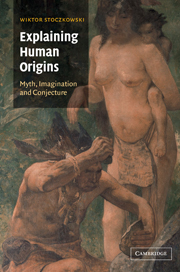Book contents
- Frontmatter
- Contents
- List of tables
- Acknowledgements
- Introduction: in which the author briefly explains his aims
- 1 Prehistory and the conditioned imagination
- 2 Anthropogenesis and science
- 3 In search of causes
- 4 Evolutionary mechanisms: the constraints of nature or of imagination?
- 5 A double game
- Bibliography
- Index
1 - Prehistory and the conditioned imagination
- Frontmatter
- Contents
- List of tables
- Acknowledgements
- Introduction: in which the author briefly explains his aims
- 1 Prehistory and the conditioned imagination
- 2 Anthropogenesis and science
- 3 In search of causes
- 4 Evolutionary mechanisms: the constraints of nature or of imagination?
- 5 A double game
- Bibliography
- Index
Summary
THE INVENTION OF PREHISTORY
On n'ouvre pas un livre de voyages où l'on ne trouve des descriptions de caractères et de mœurs: mais on est tout étonné d'y voir que ces gens qui ont tant décrit de choses, n'ont dit que ce que chacun savoit déjà.
J.-J. Rousseau, ‘Discourse sur l'origine de l'inégalité’What is conventionally known as the ‘discovery’ of America presented Europeans with a world they rapidly christened New. The first descriptions of this world were in no way new however, so much so that today they provide us with one of the most astonishing testimonies of the power by which a conceptual tradition conditions the observation of new phenomena. Throughout the century following Columbus' first expedition, the conquistadors and colonisers remained strongly attached to everything that had previously been imagined concerning the existence of some possible other world; the first representations of America were therefore inspired by images that preceded its discovery. The River Amazon was so called by Carvajal because, he asserted, women similar to those described by Homer had fought heroically against Orellana's soldiers at the mouth of the Rio Negro. The freakish Ewaipanomas, depicted by Raleigh as having eyes on their shoulders and mouths between their breasts, came straight out of Pliny's Natural History, having adorned many of the fanciful geographies of ‘Ethiopia’, Asia and the Far East.
- Type
- Chapter
- Information
- Explaining Human OriginsMyth, Imagination and Conjecture, pp. 3 - 28Publisher: Cambridge University PressPrint publication year: 2002



